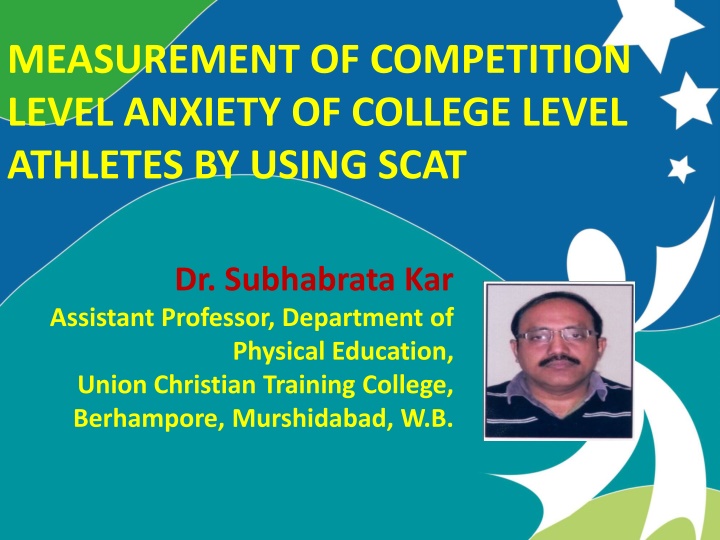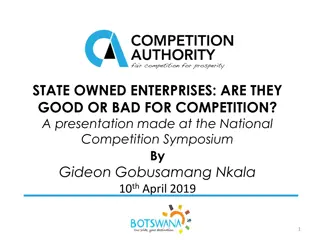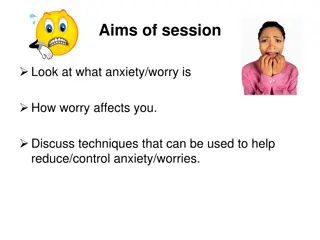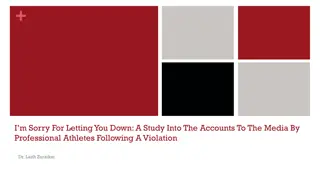Measurement of Competition Anxiety Level in College Athletes
Athletes often experience anxiety during competitions, affecting their performance. This study explores measuring competition anxiety in college track and field athletes using the SCAT test. Subjects were evaluated based on their responses to anxiety-related questions during competition scenarios.
Download Presentation

Please find below an Image/Link to download the presentation.
The content on the website is provided AS IS for your information and personal use only. It may not be sold, licensed, or shared on other websites without obtaining consent from the author.If you encounter any issues during the download, it is possible that the publisher has removed the file from their server.
You are allowed to download the files provided on this website for personal or commercial use, subject to the condition that they are used lawfully. All files are the property of their respective owners.
The content on the website is provided AS IS for your information and personal use only. It may not be sold, licensed, or shared on other websites without obtaining consent from the author.
E N D
Presentation Transcript
Introduction MEASUREMENT OF COMPETITION LEVEL ANXIETY OF COLLEGE LEVEL ATHLETES BY USING SCAT ATHLETES BY USING SCAT MEASUREMENT OF COMPETITION LEVEL ANXIETY OF COLLEGE LEVEL Introduction Dr. Subhabrata Kar Assistant Professor, Department of Physical Education, Union Christian Training College, Berhampore, Murshidabad, W.B. Dr. Subhabrata Kar Assistant Professor, Department of Physical Education, Union Christian Training College, Berhampore, Murshidabad, W.B.
INTRODUCTION All athletes experience the anxious thoughts that so frequently occur in response to stress. Throughout the course of one s career, however, the sources of stress and the kinds of anxious thoughts experienced change. The increased stress of competitions can cause athletes to react both physically and mentally in a manner which can negatively affect their performance abilities. Sports and performance anxiety often go hand-in-hand. While many athletes become "pumped up" during competition, when the rush of adrenaline is interpreted as anxiety, and negative thoughts begin to swirl, it can have devastating effects on his/her ability to perform. Before an athlete learns how to manage the symptoms of anxiety during competitions, it is important to understand the relationship between anxiety and athletic performance.
METHODS SUBJECTS: 55 male and female college going track and field athletes were selected from 120 population of Nadia & Murshidabad district of West Bengal of age group 22-25. The athletes had an average of 3 years participation experience in district, state or university level track & field competitions. Among the 55 athletes 20 were sprinters and jumpers or both (SJG), which consisted with 12 male and 8 female athletes; 20 were long distance runners (LDG), which consisted with 12 male and 8 female athletes and 15 were middle distance runners (MDG), which consisted with 10 male and five female athletes.
PROCEDURE To measure competition related anxiety of the athletes Sport Competition Anxiety Test (SCAT, developed by Rainer Martens in 1977) was introduced. Then each athlete s composite score (CS) was found. Then that score was analysed according to SCAT score analysis norms. All 55 athletes were first of all provided with following SCAT questionnaire and they were asked to give their opinion strictly independent manner. The SCAT contains 15 items, 10 of which measures symptoms associated with anxiety. The five items that are not scored are included in the inventory to reduce the likelihood of an internal response-set bias. The standard instructions of the SCAT ask respondents to indicate how they usually feel when competing in track & field competition . Subjects were also asked to mention their events and number of participating years & level of competition.
SPORT COMPETITION ANXIETY TEST: Assess how you feel about the following situations when you compete in Track & Field, using the following scale: Hardly ever A Sometimes B Often C 1. Competing against others is socially enjoyable. 2. Before I compete, I feel uneasy. ______ 3. Before I compete, I worry about not performing well. ______ 4. I am a good sport person when I compete. ______ 5. When I compete, I worry about making mistakes. ______ 6. Before I compete I am calm. ______ ______
7. 8. Setting a goal is important when competing. ______ Before I compete I get a queasy feeling in my stomach. ______ 9. Just before competing, I notice that my heart than usual. ______ beats 10. I considerable physical energy like to compete in games that .______ demand 11. 12. 13. Before I compete I feel relaxed. ______ Before I compete I am nervous. ______ Team sports are more exciting than individual sports.
14. I get nervous wanting to start the game. ______ 15. Before I compete I usually get uptight. ______ SCORING Items 1, 4, 7, 10, and 13 are filler items used to help disguise the purpose of the test; one should have to cross them our, as they will not be used for scoring. Items 2, 3, 5, 8, 9, 12, and 15 are scored in the following manner: hardly ever=1 pt., sometimes=2 pts, often=3 pts. For items 6 and 11, the scoring is reversed: hardly ever=3 pts, sometimes=2 pts, often=1 pt. Simply total the numbers for these 1- items to determine your trait anxiety score, which ranges from a low of 10, to a high of 30.
RESULTS The mainly according to Mean Composite Score (MCS) of three groups and ANOVA. All the means, S.D. and range of scores were presented in Table No. 1, 2 and 3. results were prepared
Table No.-1 Mean and S.D. of SJG Group Mean S.D. Range SJG 21.78 2.643 8 SJG Female 22.875 1.832 5 SJG Male 21.983 2.75 8 Table No.-2 Mean and S.D. of MDG Group Mean S.D. Range MDG 23.00 2.643 7 MDG Female 25.00 1.832 2 MDG Male 22.00 2.75 6 Table No.-3 Mean and S.D. of LDG Group Mean S.D. Range LDG 16.95 1.5644 6 LDG Female 17.87 1.7633 5 LDG Male 16.33 1.027 3
Table No.-4 ANOVA Table for Comparison between means Source Treatment (Between) Error Total SS 378.5773 df 2 MS 189.2886 F 38.43* p <0.000 1 256.15 634.7273 52 54 4.926 *Significant (0.01 level) Table No.-5 Tukey Post Hoc Test M1 Vs M2 M1 Vs M3 M2 Vs M3 Not Sign. M 1 = Mean of SJG M 2 = Mean of MDG M 3= Mean of LDG P<0.01 MSD = the absolute [unsigned] diff. between sample means required for significant at the designated level. HSD [0.05] for 0.05 level; HSD [0.01] for the 0.01 level. P<0.01
Fig No.1 Mean Score of SJG. Mean Score of SJG 23.5 23 22.5 22 Score 21.5 21 Over all Female Male 20.5 20 1 2 3 Fig No.-2 Percentage of athletes in different levels of anxiety of SJG. Percentage of athletes in different levels of anxiety of SJG Low- 0% High- 15% Average- 85%
Fig No.3 Mean Scores of MDG. Mean Score of MDG 25.5 25 25 24.5 24 23.5 23 Score 23 22.5 22 22 21.5 21 20.5 1 2 3 Fig No.-4 Percentage of athletes in different levels of anxiety of MDG. Percentage of athletes in different levels of anxiety of MDG Percentage of athletes in different levels of anxiety of MDG Low- 0% High- 33% Average- 67%
Fig No.5 Mean Scores of LDG. Mean Score of LDG 18 17.5 17 Score 16.5 Over all Female Male 16 15.5 1 2 3 Fig No.-6 Percentage of athletes in different levels of anxiety of LDG. Percentage of athletes in different levels of anxiety of LDG Percentage of athletes in different levels of anxiety of LDG Low- 0% Average - 50% High- 50%
Fig No.-7 Percentage of athletes in different levels of anxiety for all three Groups Percentage of athletes in different levels of anxiety for all three Groups High- 15% Low- 18% Average- 67% Fig. No.-8 Male & Female score comparison of three groups. Male & Female comparison of three groups Male-22 Male-21.083 Male- 16.33 Female-25 Female-22.875 Female-17.875 1 2 3 1=SJG 2=MDG 3-LDG
Fig.No.-10 Years of Participation of three groups. Year of participations Above 4 years 10 3 to 4 years 3 3 2 to 3 years 5 Above 4 years 5 1=SJG 2=MDG 3=LDG 3 to 4 years 5 2 2 to 3 years 7 Above 4 years 3 to 4 years 5 2 to 3 years 7 1 8 0 1 2 3 4 5 6 7 8 9 10 Number of Subjects
DISCUSSION: While considering MCS, SJG showed average level of competition anxiety (CA) with mean & SD as 21.748 2.643 where female sprinters showed on average high CA in comparison to boys. In case of MDG, the overall mean CA level was found average (23 2.221), but girls showed high level of CA (25 0.632) in comparison to all groups. On other hand, LDG showed, on average, low level of CA, i.e. overall mean and SD as 16.95 1.564. In all thee cases female showed high level of competition anxiety than male.
One way ANOVA (Table No.-4) showed significant difference between three groups in respect of SCAT composite score of the subjects of three groups. Post hoc test showed no significant difference between SJG and MDG. But significant difference found between SJG and LDG, as well as MDG and LDG.
The SJG showed that among 20 subjects 85% had average level of CA, 15 had high level of CA, but no person with low level of CA. On the other hand, MDG showed 67% of average, 33% of high and 0% of low level of CA. At the same time, LDG showed 50% 0f average, 50% of low and no high level of CA (Fig. No.-2,4 &6). While taking three groups together, 67% found average, 18% found low and 15% found high level of CA (Fig.No.-7). Fig. No.-5 shows comparison between overall means of three groups and Fig. No.-9 shows male and female comparison of three groups. Result showed that number of subjects, who participated Track & field sports more than 4 years was more in LDG than other two groups (Fig. No.-10).
CONCLUSION: In the present study SCAT was used to find out the anxiety level of college athletes in inter-collegiate and university level track and field competitions. The long distance runners showed low level of CA in comparison to sprint-jumping and middle-distance athletes. In respect of competition level anxiety score long-distance runners are different from sprint-runners and middle-distance runners. All three groups showed that female athletes have high level of CA than their male counterpart. It may be concluded that the anxiety level of athletes is increased with level of participation as well as decreased with increment of participation year in sports.
for your patience Dr. S.Kar 10 May 2013 20























